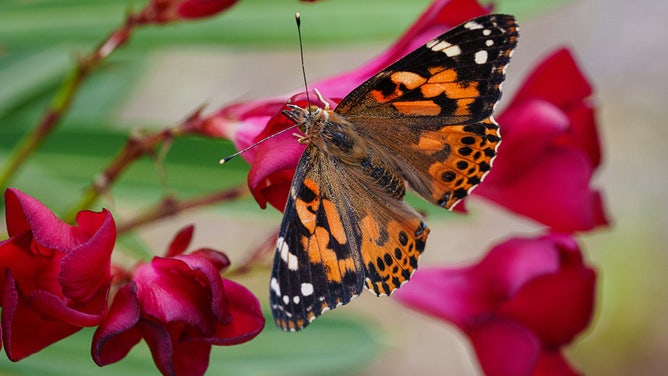Butterflies ride Saharan air layer 2,600 miles across Atlantic in first-ever insect feat
Scientists calculated that the 2,600-mile flight across the ocean without any stop lasted between 5 and 8 days, thanks to favorable Saharan air layer wind currents making it energetically possible.
FILE – Monarch butterflies officially designated as endangered
Monarch butterflies have officially been designated as endangered by the International Union for Conservation of Nature.
FRENCH GUIANA, South America – A new record of insect migration has been linked to wind patterns and the Saharan air layer, as a team of international researchers has recognized a butterfly species' transoceanic journey across the Atlantic.
Scientist Gerard Talavera from the Botanical Institute of Barcelona found many painted lady butterflies on the beaches of French Guiana by the Atlantic Ocean back in 2013. The discovery was surprising at the time because these butterflies are not usually found in South America.

A painted lady butterfly.
(Gerard Talavera)
Thanks to an analysis of pollen DNA, it was confirmed that the butterflies visited flowers in tropical Africa. Stable isotopes in their wings also suggested that they likely originated from western European countries.
Researchers also analyzed wind trajectories, finding a sustained directional pattern from West Africa which suggested that the butterflies had crossed the Atlantic.
‘Extraordinary feat for such a small insect’
Scientists calculated that the 2.600-mile flight across the ocean without any stop lasted between 5 and 8 days, thanks to favorable wind currents making it energetically possible, according to the Spanish National Research Council (CSIC). The researchers also highlighted the importance of the Saharan air layer as a potential aerial highway for dispersion.
Hot, dry air rises from the surface of the Saharan Desert and carries with it fine particles of dust from the desert sands. That dust-laden air climbs to the highest reaches of the atmosphere, where winds called the Easterlies or Trade Winds (blowing from east to west) carry that dust about 3,000 miles across the Atlantic Ocean into the Western Hemisphere.
The dusty, dry wind limits tropical development in the Atlantic, while it can also degrade visibility and air quality when it reaches American shores along the Gulf Coast.
5 THINGS TO KNOW ABOUT THE SAHARAN DUST PLUME

A painted lady butterfly rests on a flowering bush on May 11, 2024, in Gulf Shores, Alabama.
(J. David Ake / Getty Images)
The butterflies' journey could have been even longer, potentially spanning over 4,300 miles and involving three continents, including Europe, notes Clement Bataille, a University of Ottawa professor in Canada and study co-author.
"This is an extraordinary feat for such a small insect," he explains.
The insects could only have completed this flight using a strategy alternating between minimal effort to avoid falling into the sea, facilitated by ascending winds and active flight, which requires more energy consumption, according to Eric Toro-Delgado, one of the authors of the paper.
"We estimate that without wind, the butterflies could have flown a maximum of (484 miles) before exhausting all their fat and thus their energy," he adds.
A LOOK AT A PHENOMENON THAT COULD DERAIL AN ACTIVE HURRICANE SEASON
FILE – Fast facts about monarch butterflies
Learn more about migratory monarch butterflies -- the iconic orange-and-black insects that signal spring and summer.
The discovery opens new perspectives on insects' ability to disperse over long distances, even across seas and oceans.
"It is possible that we are underestimating the frequency and impact of these movements on our ecosystems," said Gerard Talavera, leader of the study. "Throughout history, migratory phenomena have been important in defining the distributions of species that we observe today."
Researchers said that due to global warming, others may witness more long-distance dispersal events like this in the future, which could have significant impacts on biodiversity and ecosystems worldwide.
The study, recently published in the journal Nature Communications, involved researchers from Barcelona, Poland, Canada and the U.S.

